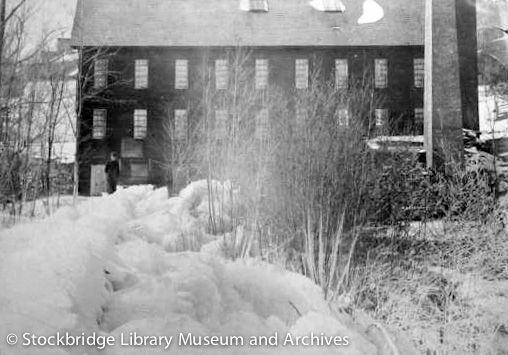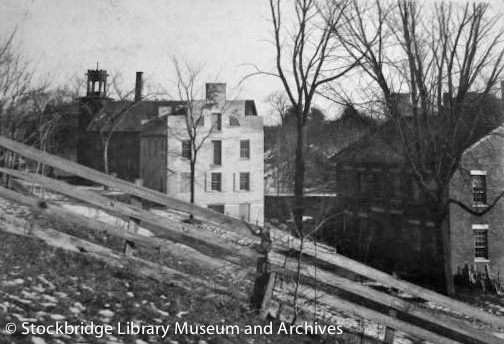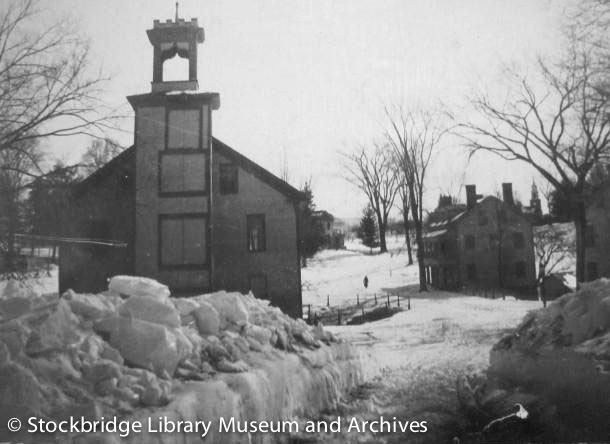[This article was originally published by the Stockbridge Library Museum and Archives
in the July 2012 issue of Now and Then on page 2. It appears here with permission.
© Stockbridge Library Museum and Archives]
 On Nov. 24th, 1864 the Pittsfield Sun reported
that “Messers Barker have recently purchased the mill privilege of
A. E. Dickinson in Curtisville, and are about to erect a fine woolen
mill, which will employ from 50 to 100 hands”. Around 1867-68 the
new Mahkeenac Mill was erected for about $15,000 on the site of
Dickinson’s mill which had burned in 1852. It was built of wood,
fronted the road to Lenox (Interlaken Road/Route 183) and
extended over the Marsh Brook which ran from Newton Pond (later
known as the Cove). More
power was needed so the sluiceway and dam on the south end of Newton
Pond were built as part of the Barker Mill project. The channel
course from the outlet of the lake was dug out using oxen. This
higher ditch and bulkhead gave a 36 foot fall of water power. A paper
written by E. E. Barker stated “This
construction for water power caused overflow damages and the buying
up of all water rights all around the lake and constituted the Barker
Water Rights and water privilege”.
On Nov. 24th, 1864 the Pittsfield Sun reported
that “Messers Barker have recently purchased the mill privilege of
A. E. Dickinson in Curtisville, and are about to erect a fine woolen
mill, which will employ from 50 to 100 hands”. Around 1867-68 the
new Mahkeenac Mill was erected for about $15,000 on the site of
Dickinson’s mill which had burned in 1852. It was built of wood,
fronted the road to Lenox (Interlaken Road/Route 183) and
extended over the Marsh Brook which ran from Newton Pond (later
known as the Cove). More
power was needed so the sluiceway and dam on the south end of Newton
Pond were built as part of the Barker Mill project. The channel
course from the outlet of the lake was dug out using oxen. This
higher ditch and bulkhead gave a 36 foot fall of water power. A paper
written by E. E. Barker stated “This
construction for water power caused overflow damages and the buying
up of all water rights all around the lake and constituted the Barker
Water Rights and water privilege”.
A water wheel located at
the south end of the cellar ran the grinding machinery and a furnace
was located at the north end of the cellar. Making woolen cloth
turned out to be too expensive an enterprise; and the mill turned to
other uses. As late as 1885 it was operated for a number of years by
Otis Barker and his sons Frank and Ed as a saw mill and grist mill
with a foundry attached. One section of the basement was used as the
foundry and the other as a grist mill; while the upper stories used
for wood working purposes. Iron posts and fencing, some of which
still exist in the village today, were cast in the 1890’s at the
foundry. They also made square boxes and grates for sluices, casts
for lamp lighter planes and shares for plows.
B. F. Barker was a
pattern maker and made most of the patterns used in the foundry work.
He was also an inventor and invented a Wire Broom Protector, a Lamp
Lighter Plane and a Corn Cracker to reduce ears of corn. He invented
and patented a machine for separating splints from pulp, called a
“splint-sifter”. He held a number of U.S. patents, including one
for “Improvement in Machine for Molding Paper Pulp” (1875) for
new and useful improvements relating to molding articles of
papier-mâché (a copy of the patent is in the M&A). He
was also involved in the building and/or planning of the 2 Stone Arch
Bridges (one near the Barker Mill and one in Larrywaug).
 Benjamin F. Barker
served as selectman and was also highway surveyor for the town. The
Curtis house, just north of the mill, and a couple of small cottages
near the mill were owned by the Barker family. Ed Barker, son of B.
F. Barker, helped his father in the mill and was Post Master. Emma
and Tina Barker, daughters of B. F. Barker, carried the mail to and
from Stockbridge. Otis Barker, brother of B. F. Barker, owned the
hotel and brick store near the Barker mill (the
post office was in the brick store). Otis
also owned the tenement buildings below the store (some
stone foundations are all that left of them today; see picture right
showing, left rear to right, the mill, brick store and tenement
bldgs.).
Benjamin F. Barker
served as selectman and was also highway surveyor for the town. The
Curtis house, just north of the mill, and a couple of small cottages
near the mill were owned by the Barker family. Ed Barker, son of B.
F. Barker, helped his father in the mill and was Post Master. Emma
and Tina Barker, daughters of B. F. Barker, carried the mail to and
from Stockbridge. Otis Barker, brother of B. F. Barker, owned the
hotel and brick store near the Barker mill (the
post office was in the brick store). Otis
also owned the tenement buildings below the store (some
stone foundations are all that left of them today; see picture right
showing, left rear to right, the mill, brick store and tenement
bldgs.).
In 1870 the Pittsfield Sun reported
that the manufacture of pulp was being done at the Barker Mill. One
source stated that Albrecht Pagenstecher formed a co-partnership with
Benjamin Barker of Barker Bros. in Pittsfield and that they would
soon be making pulp in the large new factory at Curtisville which had
been erected for a woolen mill. B. F. Barker invented and patented
the Barker Wood Pulp Machines. The 2 brothers, Isaac and George W.
Barker, formed a company with him. Machines were made in Curtisville
and some were also used in the Smith Paper Company Mill in Lee. The
business making pulp only ran for a few years.
 The mill struggled
economically, even after diversifying. In 1892 it was sold to Leonard
F. Beckwith, an engineer from New York. Beckwith did extensive repair
work on the mill and water works and had great plans for the mill and
the village. B. F. Barker was Superintendent during this period,
until 1893 when Beckwith was suddenly taken ill at the Chicago
World’s Fair and died a year or two later, after which the mill was
abandoned. The building was eventually demolished in 1927 leaving
only a few foundation stones to show that it ever existed. (picture
left shows mill with hotel in background and brick store far right)
The mill struggled
economically, even after diversifying. In 1892 it was sold to Leonard
F. Beckwith, an engineer from New York. Beckwith did extensive repair
work on the mill and water works and had great plans for the mill and
the village. B. F. Barker was Superintendent during this period,
until 1893 when Beckwith was suddenly taken ill at the Chicago
World’s Fair and died a year or two later, after which the mill was
abandoned. The building was eventually demolished in 1927 leaving
only a few foundation stones to show that it ever existed. (picture
left shows mill with hotel in background and brick store far right)
 On Nov. 24th, 1864 the Pittsfield Sun reported
that “Messers Barker have recently purchased the mill privilege of
A. E. Dickinson in Curtisville, and are about to erect a fine woolen
mill, which will employ from 50 to 100 hands”. Around 1867-68 the
new Mahkeenac Mill was erected for about $15,000 on the site of
Dickinson’s mill which had burned in 1852. It was built of wood,
fronted the road to Lenox (Interlaken Road/Route 183) and
extended over the Marsh Brook which ran from Newton Pond (later
known as the Cove). More
power was needed so the sluiceway and dam on the south end of Newton
Pond were built as part of the Barker Mill project. The channel
course from the outlet of the lake was dug out using oxen. This
higher ditch and bulkhead gave a 36 foot fall of water power. A paper
written by E. E. Barker stated “This
construction for water power caused overflow damages and the buying
up of all water rights all around the lake and constituted the Barker
Water Rights and water privilege”.
On Nov. 24th, 1864 the Pittsfield Sun reported
that “Messers Barker have recently purchased the mill privilege of
A. E. Dickinson in Curtisville, and are about to erect a fine woolen
mill, which will employ from 50 to 100 hands”. Around 1867-68 the
new Mahkeenac Mill was erected for about $15,000 on the site of
Dickinson’s mill which had burned in 1852. It was built of wood,
fronted the road to Lenox (Interlaken Road/Route 183) and
extended over the Marsh Brook which ran from Newton Pond (later
known as the Cove). More
power was needed so the sluiceway and dam on the south end of Newton
Pond were built as part of the Barker Mill project. The channel
course from the outlet of the lake was dug out using oxen. This
higher ditch and bulkhead gave a 36 foot fall of water power. A paper
written by E. E. Barker stated “This
construction for water power caused overflow damages and the buying
up of all water rights all around the lake and constituted the Barker
Water Rights and water privilege”.
 Benjamin F. Barker
served as selectman and was also highway surveyor for the town. The
Curtis house, just north of the mill, and a couple of small cottages
near the mill were owned by the Barker family. Ed Barker, son of B.
F. Barker, helped his father in the mill and was Post Master. Emma
and Tina Barker, daughters of B. F. Barker, carried the mail to and
from Stockbridge. Otis Barker, brother of B. F. Barker, owned the
hotel and brick store near the Barker mill (the
post office was in the brick store). Otis
also owned the tenement buildings below the store (some
stone foundations are all that left of them today; see picture right
showing, left rear to right, the mill, brick store and tenement
bldgs.).
Benjamin F. Barker
served as selectman and was also highway surveyor for the town. The
Curtis house, just north of the mill, and a couple of small cottages
near the mill were owned by the Barker family. Ed Barker, son of B.
F. Barker, helped his father in the mill and was Post Master. Emma
and Tina Barker, daughters of B. F. Barker, carried the mail to and
from Stockbridge. Otis Barker, brother of B. F. Barker, owned the
hotel and brick store near the Barker mill (the
post office was in the brick store). Otis
also owned the tenement buildings below the store (some
stone foundations are all that left of them today; see picture right
showing, left rear to right, the mill, brick store and tenement
bldgs.).
 The mill struggled
economically, even after diversifying. In 1892 it was sold to Leonard
F. Beckwith, an engineer from New York. Beckwith did extensive repair
work on the mill and water works and had great plans for the mill and
the village. B. F. Barker was Superintendent during this period,
until 1893 when Beckwith was suddenly taken ill at the Chicago
World’s Fair and died a year or two later, after which the mill was
abandoned. The building was eventually demolished in 1927 leaving
only a few foundation stones to show that it ever existed. (picture
left shows mill with hotel in background and brick store far right)
The mill struggled
economically, even after diversifying. In 1892 it was sold to Leonard
F. Beckwith, an engineer from New York. Beckwith did extensive repair
work on the mill and water works and had great plans for the mill and
the village. B. F. Barker was Superintendent during this period,
until 1893 when Beckwith was suddenly taken ill at the Chicago
World’s Fair and died a year or two later, after which the mill was
abandoned. The building was eventually demolished in 1927 leaving
only a few foundation stones to show that it ever existed. (picture
left shows mill with hotel in background and brick store far right)